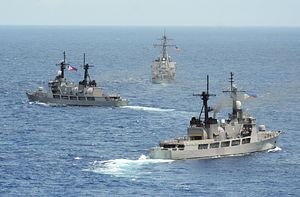Last week, Philippine Defense Secretary Voltaire Gazmin requested military assistance from the head of U.S. Pacific Command, Admiral Harry Harris Jr., to strengthen the Philippines’ position in the South China Sea, AFP reports.
According to Colonel Restituto Padilla, a military spokersperson of the Armed Forces of the Philippines (AFP), “[i]t was a specific request on the part of the secretary of national defense to Harris to get their assistance in… resupplying and rotating troops.”
He emphasized that Admiral Harris made no commitment during the meeting to fulfill the request concerning the “West Philippine Sea” (Manila’s name for the closest section of South China Sea). “They just took our requests and the details still have to be discussed,” Padilla said. Reuters, however, did report that U.S. Vice Admiral Alexander Lopez told local media that Harris pledged his support to help the United States’ oldest ally in the Asia-Pacific region.
The Philippines specifically asked the United States for assistance in monitoring the situation in the South China Sea in “real-time” by providing surveillance and reconnaissance assets, as well as air cover to a civilian ship that supplies military personnel stationed on and around the Second Thomas Shoal.
“If there are Americans flying around there, we won’t be troubled. We need to be helped in our resupply missions. The best way they could assist is through their presence,” Gazmin told AP.
“We want the U.S. military to watch over our ships, which China attempts to block every time we rotate troops and bring supplies to a ship that ran aground on Ayungin Shoal,” Padilla reiterated.
During their talks, Gazmin and Harris also discussed the Pentagon’s new Asia-Pacific Maritime Security Strategy which, while noting that “the United States takes no position on competing sovereignty claims to land features in the region,” slightly reprimands Manila. “Although we applaud the Philippines’ and Vietnam’s efforts to bring its maritime claims in line with the Law of the Sea Convention, more work remains to be done,” the document reads.
Both sides also agreed to boost the interoperability of U.S. with Philippine forces.“It was agreed that developing the capability of the AFP is of paramount importance, specifically in the areas of intelligence, surveillance and reconnaissance, and command and control,” Philippine defense department spokesman Peter Galvez told the Philippine Star after the consultations. The United States is providing around $50 million in direct military aid to the Philippines this year.
As I reported last week, (See: “Philippines Push For Military Modernization in New Budget Proposal”), Manila is planning a 25 percent increase in the a portion of its 2016 defense budget dedicated to the modernization of AFP in order to reinforce its military assets in the South China Sea.

































